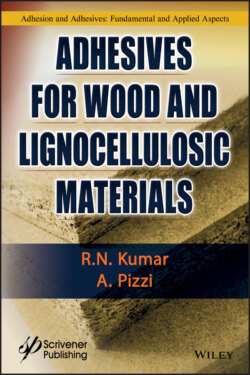Читать книгу Adhesives for Wood and Lignocellulosic Materials - R. N. Kumar - Страница 67
2.15 Weak Boundary Layer Theory
ОглавлениеThe weak boundary layer theory explains the loss of adhesion as a failure in an intermediate molecular layer between adhesive and adherent [35]. This molecular layer consists of low-molecular-weight impurities of various origins including water. This theory has never been verified for wood, but it is known that low-molecular-weight extractives can easily migrate to the surface and might reduce adhesion due to weak boundary layer (see Chapter 9).
Bonding of wood is described as a chain of several links, comprising wood, wood surface and its boundary layer, interphase of wood and adhesive and interface between wood and adhesive, and the adhesive bond line itself.
One useful method for understanding the abovementioned links that control the adhesive strength as well as weakness is the chain link analogy proposed by Marra [5]. Different areas of the substrate and adhesive are likened to a series of chain links, with the weakest link being the site of fracture. This is depicted in Figure 2.7. These links are as follows:
Figure 2.7 Different links in adhesive bonding.
Link 1, adhesive film; links 2 and 3, intra-adhesive boundary layers; links 4 and 5, adhesive–adherend interface (in this region, the weak boundary layer exist); links 6 and 7, adherend subsurface; links 8 and 9, adherend proper.
Another cause for weak link is due to the stresses caused at the bond line due to swelling and shrinkage due to moisture changes. If the adhesive bond has to be durable, it has to adapt itself to the dimensional changes and the consequent strain due to swelling and shrinkage accompanying the changes in moisture conditions. Two distinct classes of wood adhesives have different ways to distribute this strain: (a) rigid in situ polymerized adhesives relieves this stress in many cases by distributing the strain through the wood interphase region. (b) The other class, the more flexible pre-polymerized adhesives, can distribute the strain through the adhesive interphase. Failure to adequately perform either of these strain distribution processes can lead to high strains and subsequent failure zones. As wood dries, it shrinks back to near its original dimensions. These failure zones can expand and become more visible as delamination areas [36].
Mechanically weak wood surfaces can be another source of weak boundary layer. The causes of this are many [5, 35]. One cause is physical crushing of the surface, especially by abrasive planing or by too high of a bonding pressure. This occurs when more pressure is applied than the thin-walled earlywood cells can withstand. The strength of these cells is reduced due to deformation and fracture of the cell walls. A second cause is sanding dust or other dust accumulation on surfaces. A third cause is tearing of the surface that occurs during planing and sanding. A fourth cause, associated with high-density wood species, is cells becoming separated from one another due to the force of planning [36].
